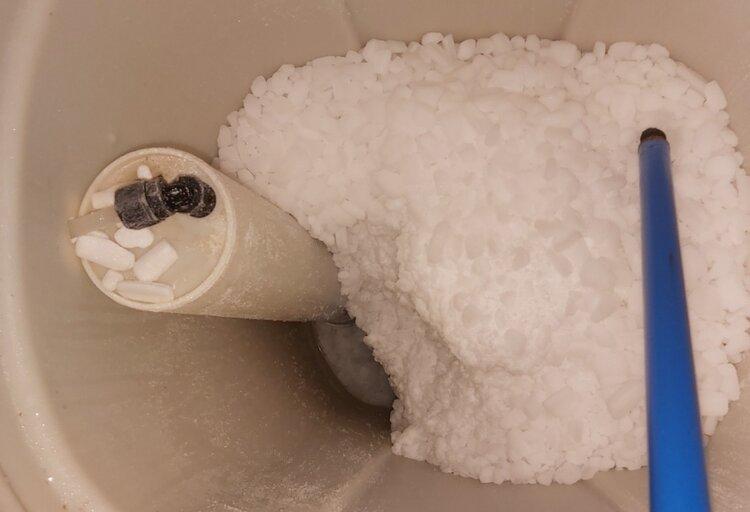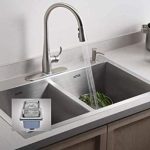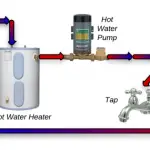Have you noticed that your water softener is no longer working as it was expected to? One of the prime reasons that can cause issues with the water softener’s functionality can be the formation of a salt bridge inside the water softener. Do not fret, though. There are several ways that you can implement to fix the salt bridge formed inside the water softener.
Fixing the salt bridge is quite easy. Scoop out the salt from the upper side of the salt bridge, and then use a long-handled item to break the crust of the bridge. Remove the larger chunky pieces and then discard them. Once the salt bridge has been removed, clean the brine tank and fill the appropriate amount of salt.
What is a Water Softener Salt Bridge?
A salt bridge is a solidified layer of salt that can cover the complete diameter of the brine tank. This can create a blockage for salt, which cannot come in contact with the water to soften it. The salt bridge can form when the brine tank is saturated with the salt, and this causes the salt to crystallize and results in the formation of the salt bridge.
The salt bridge is most likely to form when the water level in the tank goes too low. It can also be a result of the tank needing to be cleaned more often. I had a couple of water softeners at my home and found one of them having frequent salt bridge formation. One of the reasons for the same was the heavy concentration of the salt in the water.

How to Remove a Water Softener Salt Bridge – Step by Step Guide
Here are the steps involved in how to remove water softener salt bridge without hassles:
Step 1: Turn off the water
Turning off the water will help you stop the source of the salt bridge, to begin with. That way, you will be to ensure that the salt bridge does not continue to form.
Step 2: Break the salt
Take a long handled tool such as a broom and tap the salt bridge with the handle side. Keep tapping on it until the crust is broken. A mop handle should work great in most of the cases.
Step 3: Remove the loose pellets
Scoop out the loose pellets from the top of the tank. You can use a container for the purpose. Hammer the edges of the salt bridge slightly. Make sure that you are not damaging the tank in the process.
Step 4: Vacuum out the water
The next step is to vacuum out the water from the tank. You can perform a wet and dry vacuum as per your preferences. Drain out everything completely.
Step 5: Turn the water back on
The next step is to turn the water back on. Ensure that you have followed the instructions to regenerate the water in the softener carefully.
What Causes a Salt Bridge in a Water Softener?
Salt bridges can form due to several reasons. The primary cause is the difficulty in dissolving the salt successfully. Despite the fact that you have a new and efficient water softener, you are likely to get a salt bridge in many cases, and it may also be a fault of your salt.
Some of the reasons that can cause the formation of the salt bridge can be
Low quality of the salt
If you have chosen the low-quality salt, it may fail to dissolve properly. One possibility is that the salt is too fine.
The brine tank is not clean
The brine tank may be unclean, and it can result in the formation of salt bridges. It is always advisable to maintain the water softener as per the instructions provided by the water softener manufacturer. The tank that needs to be cleaned may help affect the proper dissolution of the salt.
The level of the water in the brine tank is too low
Yet another cause for the formation of the salt bridge can be the low level of water in the brine tank. The water level in the brine tank can get too low, and that can cause the salt to begin crystallizing.
Humidity
Heavy humidity is yet another reason that can cause the formation of the salt bridge in your water softener. The humid atmosphere will make the moisture reach the inside of the brine tank. This can make the salt dissolve only partially. This can eventually make the salt form clusters.
How to Prevent Salt Bridges in a Water Softener?
Avoid filling more salt in humid environments and ensure that there is no water leakage of any sort. Making arrangements for taking care of humidity would be the right step in helping you fix the issue of salt bridge formation.
Making every attempt at reducing the humidity near your water softener is the key to achieving the right steps in avoiding salt bridge formation. You should also ensure that warm air and moistness do not enter your water softener. Yet another option is to keep the lids of your water softener closed tightly at all times.
Never fill the brine tank to the fullest capability. It should be a rule to fill the brine tank to 1/3 to 2/3 full. This will avoid salt saturation and that way, you can assure yourself that the salt is not concentrated inside the water softener.
What If the Problem is Not a Salt Bridge? Is Your Salt at Fault?
At times, it may be possible that the salt bridge is not an issue, and that is different from what is causing the problem for you. The softener may have a host of other causes and reasons that may be resulting in the formation of a salt bridge.
If you are facing repeated occurrences of salt bridge formation, the choice of your salt may be a cause. Not every water softener salt may be the same. The salt comes in different shapes, sizes, and construction. They may also have different purity levels.
Is your salt at fault? The salt with the purity levels at its best can be highly soluble, and it would be better suited for your water softener. When you choose a water softener salt, make sure that you have paid enough attention to water hardness levels, softener design, and household water usage.
Frequently Asked Questions
The Concluding Thoughts
Having a good knowledge of the common problems associated with the water softener will ensure that you are better equipped with the information to deal with the issues. Treating the formation of the salt bridge is one such occasion. The tips and ideas above should help you arrive at the best options in this context.












Add Comment